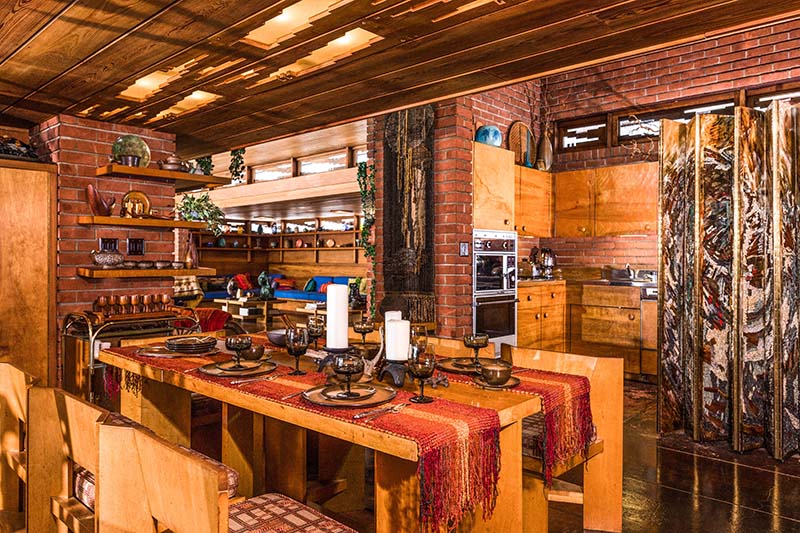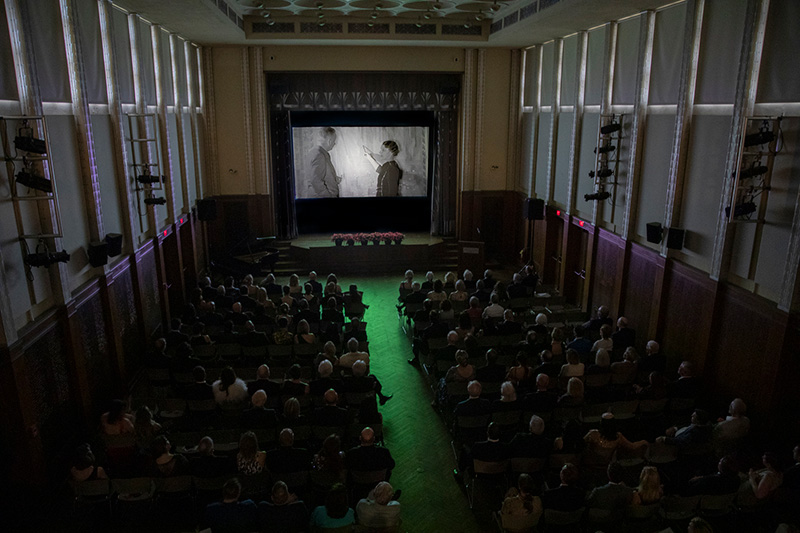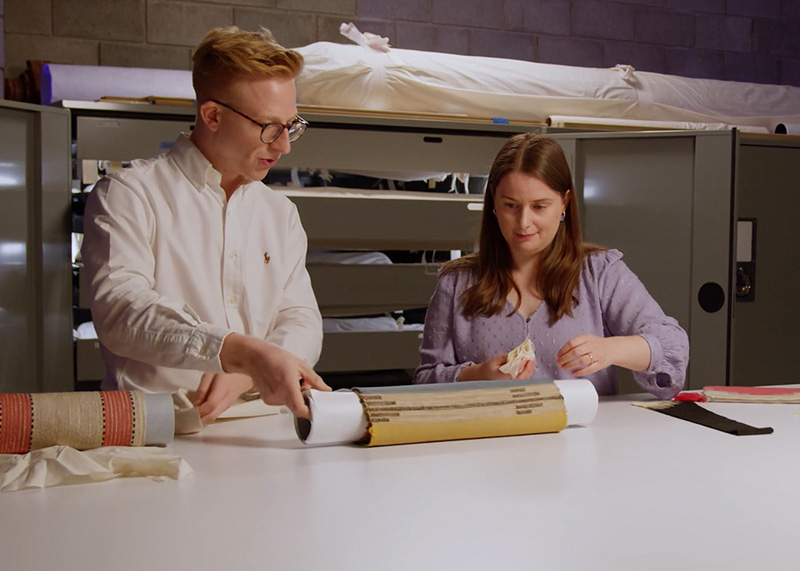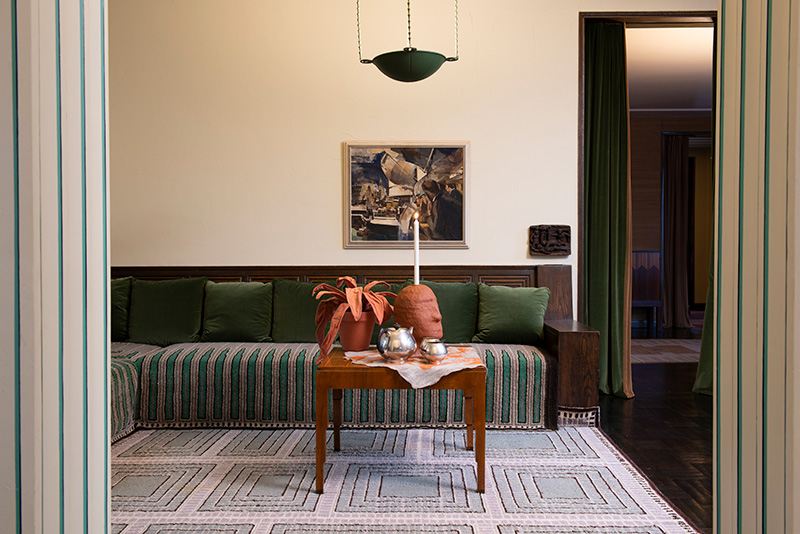A Life Full of Art: Collections and Connections at Cranbrook’s Smith House
by Nina Blomfield
There are few places that embody the concept of the Gesamtkunstwerk, or the total work of art, like Cranbrook. Founded in the early 20th century, Cranbrook Educational Community occupies a national historic landmark campus where art, architecture, and education are interwoven with daily life. At the nearby Frank Lloyd Wright Smith House, a recent addition to Cranbrook’s cultural properties, the principles of the Arts and Crafts were taken to heart by two teachers who made the total design of their home their life’s work. With a small team and an ambitious calendar of events and public programs, the Cranbrook Center for Collections and Research (CCCR) cares for Cranbrook and shares the community’s history and legacy, including its cultural properties and historic campus. I joined CCCR as the Decorative Arts Trust Marie Zimmermann Resident Collections Fellow in the summer of 2021. In my first year as the Collections Fellow, I have participated in almost all aspects of the Center’s operations and been totally immersed in this work of art. I am grateful for the generous support of the Decorative Arts Trust and the Marie and John Zimmermann Fund in enabling me to live and learn in these beautifully crafted surroundings.
My primary responsibility as the Collections Fellow during my two-year tenure is the documentation of the decorative arts collection of the Melvyn Maxwell and Sara Stein Smith House (figure 1), located about a mile from the Cranbrook campus in Bloomfield Hills, MI. Designed by Frank Lloyd Wright in 1946 and completed in 1950, the Smith House is an incredibly well-preserved example of Wright’s Usonian architecture, with a modest L-shaped floor plan executed in a simplified palate of glass, brick, cypress, and pigmented concrete. The balanced proportions of the cantilevered roofline, the rhythmic geometry of the clerestory window designs, and the shifting color relationships of the tidewater red cypress exterior and the surrounding oak trees all contribute to the harmonious relationship between house and landscape.
Smith House is more than just a beautifully designed dwelling. This historic home tells the compelling story of Melvyn and Sara Smith’s efforts to build a life full of art. Detroit public school teachers from large immigrant families, the Smiths (figure 2) made major personal sacrifices to realize their dream of living in a Frank Lloyd Wright-designed house, overcoming antisemitic discrimination from realtors and neighbors in order to build their residence in redlined Bloomfield Hills. In the decades that followed, the couple filled their home with objects that reflected a deep love of art and music. They purchased works from young artists befriended at Cranbrook Academy of Art and the College of Creative Studies in Detroit and acquired ceramics, glass, wood, and fiber art from local and national artists that testify to the renewed vitality of craft communities in the mid-20th century.
Although the decorative arts of the Smith House were enjoyed by the Smiths during their lifetimes and shared with their many guests over the years, the holdings had yet to be fully documented by the CCCR. My first tasks were to assess prior work on the collection and to determine a strategy for research that would deepen our understanding of when, how, and why the Smiths brought objects into their home. Subsequent work focused on surveying the Smith Papers in the Cranbrook Archives to determine the provenance of objects and track relationships with artists. Archival research and correspondence with living artists represented at Smith House has already broadened our view of the couple’s collecting practices and the development of their patronage of the local artistic community. This new scholarship will be made publicly accessible through the development of an online collections portal and in contributions to a forthcoming publication on Smith House, projects which I have helped develop.
Remarkably, the contents of Smith House were preserved intact after the passing of Melvyn in 1984 and Sara in 2005, and the Smiths remain the only family to occupy the house before the Towbes Foundation donated it to Cranbrook in 2017. Maintaining the structure and collection is a key aspect of my fellowship, and the associated tasks have included everything from liaising with the Collections Interpreters on public tours and conducting special tours myself, to reinstalling parts of the interior to a historically accurate state, to conservation and maintenance of the exterior architectural elements and sculpture. The Smith House collection was never formally accessioned, and I am preparing accession recommendations and presenting these for approval at Board of Trustees committee meetings as my research progresses.
Smith House has been at the center of my curatorial and collections management work, but I have enjoyed many opportunities to learn about the essential operations of an institution like Cranbrook, including systems of governance and aspects of fundraising and development. One of the most rewarding projects has been the production of Room for a Lady: Loja Saarinen at Cranbrook (2022), a documentary film on the life and work of Finnish-American designer Loja Saarinen that premiered at the Center’s annual fundraiser (figure 5). The film offers a new perspective on Saarinen as both an entrepreneur who established Cranbrook Academy of Art’s first Weaving Department, and a multi-talented artist whose textiles, architectural models, photographs, and landscape designs played an integral role in the conception and construction of Cranbrook as a total work of art. I assisted the Center’s Curator, Kevin Adkisson, with the production and editing (figure 6) and made my on-camera debut to discuss how historic gender roles and issues of attribution and documentation have obscured our understanding of Loja Saarinen’s work at Cranbrook (figure 7).
Cranbrook is one of the few Arts and Crafts enterprises of the early 20th century that continues its mission of entwining art and education, which it accomplishes through a graduate-degree awarding Academy of Art and a Pre-K through 12 school community. Working with current students at the middle school, high school, and graduate level has enlivened my fellowship experience. In February and March of 2022, I co-curated Brought to the Table: New Work from Cranbrook Academy of Art Students and Artists-in-Residence with Kevin Adkisson and Artist-in Residence and Head of Metalsmithing Iris Eichenberg (figures 8 and 9). Academy students were invited to engage with the history of decorative arts at Cranbrook by producing site-specific works for tables in Smith House, Saarinen House (the 1930 house of Loja Saarinen and first Academy President Eliel Saarinen), and Cranbrook House (the 1908–1919 manor home of Cranbrook founders George and Ellen Booth). This was my first curatorial experience with contemporary art and its ability to animate, interrogate, and destabilize our expectations of historic interior spaces. I am looking forward to new cross-campus collaborations in the year to come.
The Decorative Arts Trust Marie Zimmermann Resident Collections Fellowship has been an incredibly valuable opportunity to grow as a scholar and museum professional. I came to Cranbrook as a PhD Candidate in the History of Art at Bryn Mawr College, where my studies have focused on domestic interior decoration in the late 19th century, and Smith House has allowed me to push my academic interest in artisanry and design much further into the 20th century. I am grateful for this chance to get to know Melvyn and Sara Smith, to make new discoveries about their home and their collection, and at the same time, to gain insights into the significant but necessary behind-the-scenes workings that make such scholarship possible. I am excited to share what I have learned with Decorative Arts Trust members during a special program in July 2023.
Nina Blomfield is the Decorative Arts Trust Marie Zimmermann Resident Collections Fellow at the Cranbrook Center for Collections and Research.
A print version of this article was published in The Magazine of the Decorative Arts Trust, one of our most popular member benefits. Join today!









